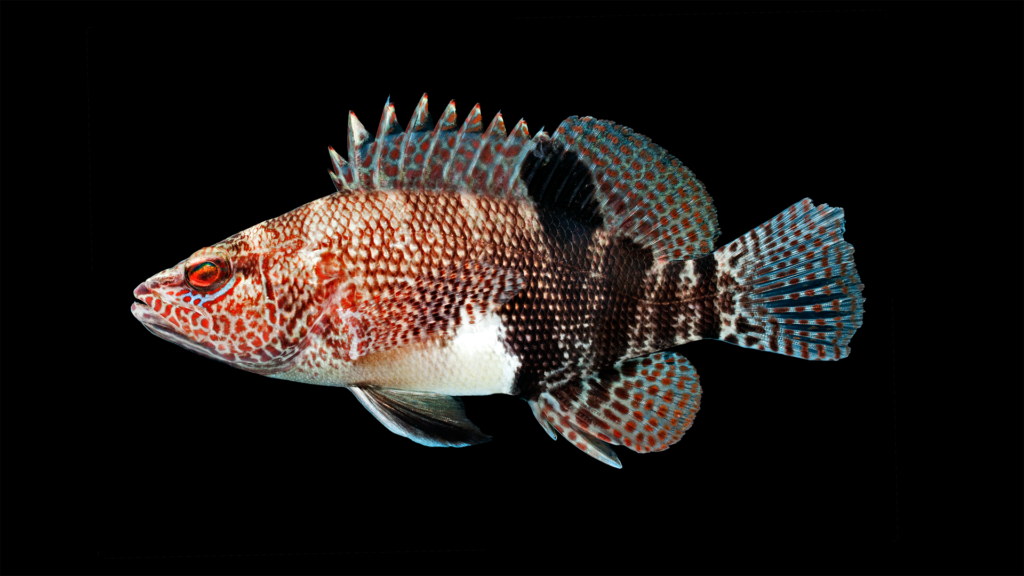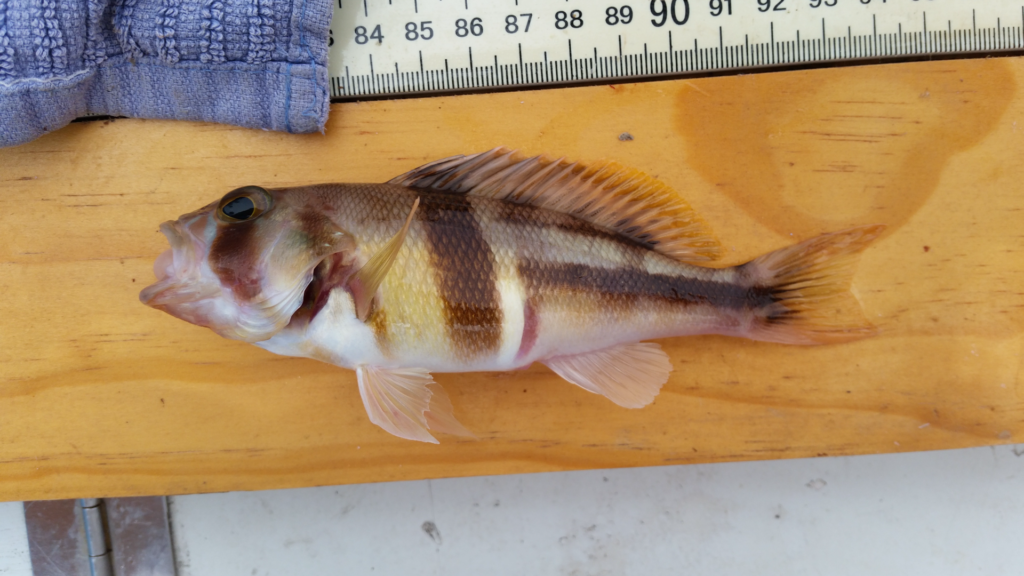| Family | Scientific Name | Author | Year | Common Name |
| Serranidae | Serranus notospilus | Longley | 1935 | Saddle Bass |
All Serranus — Dorsal fin with 10 spines and 10-14 rays. Anal fin with 3 spines and 6-13 rays. Most of upper edge of operculum free, not connected by skin to body. Caudal fin of adults truncate or emarginate. Head larger, its length contained 2.3-3.3 times in standard length. Preopercle without a large antrorse spine; middle opercle spine not reaching edge of operculum. Front nostrils variously shaped, but always closer to rear nostrils than to upper lip. Supramaxilla absent. Teeth fixed (not depressible). No scaly flap of skin joining upper part of pectoral-fin base to body. Soft dorsal and anal fins mostly naked (hence the rays are easy to count). Scales larger, the lateral scale series about the same number (39-55) as the lateral-line scales. Preopercle not expanded posteriorly, the serrae at the angle only slightly enlarged. Upper jaw moderately protrusile; jaw teeth distinct; vomer and palatines with teeth. Body depth 27-48% standard length. Posterior process of premaxilla broad and near tip of alveolar ramus. Scales 31-64 in lateral line. Total gill rakers 14-31. Branched caudal-fin rays 13-15. No obvious filaments at tips of dorsal-fin spines. Pectoral-fin rays 13-17. Lateral-line scales 39-63. Caudal-fin branched rays 8+7.
Serranus notospilus
Unique Characters: Top of head scaly forward to rear end of interorbital region. Opercle spines poorly developed. Scales weakly ctenoid and often deciduous. No black mark on inner side of opercle; black blotch in middle of soft dorsal fin, usually continued ventrally on body as a dark bar. Body usually dusky, with a white area from anus to lateral line and a dark vertical bar on caudal peduncle. Head silvery, with a broad brown band from eye to interopercle. Juveniles with nearly vertical black bar on body from dorsal-fin spines 3, 4, and 5 and another from dorsal-fin soft rays 5, 6, and 7, both bars cross dorsal fin and become fainter on ventral part of body. 3 dark stripes: the first from eye to upper caudal peduncle; second stripe from behind eye to base of first dorsal soft-ray, and third stripe from nape to base of fourth dorsal-fin spine.
Similar Species:
Blackear Bass
Serranus atrobranchus
Belted Sandfish
Serranus subligarius
Blackear Bass Serranus atrobranchus. Top of head scaly forward to rear end of interorbital region. Opercle spines poorly developed. Scales weakly ctenoid and often deciduous. Inner surface of opercle with black mark just anterior to and slightly below middle spine. Rows of cheek scales 5. Total gill rakers on first arch 15-20. Pectoral-fin rays 15-17.
Belted Sandfish Serranus subligarius. Top of head naked; opercle spines well developed. Scales strongly ctenoid, not deciduous. Body reddish brown; belly white, sharply delimited from surrounding color; large black blotch on anterior soft dorsal-fin rays and continuing ventrally on body as the first of 4 dark vertical bars. Median and pectoral fins covered with small dark brown or blackish spots. Dorsal-fin soft rays 12-14; pectoral-fin rays 15-17. Gill rakers 15-19. Lateral-line scales 42-46.
Tobaccofish
Serranus tabacarius
Snow Bass
Serranus chionaraia
Tabaccofish Serranus tabacarius. Top of head naked; opercle spines well developed. Scales strongly ctenoid, not deciduous. Dorsal-fin soft rays 10-12 (rarely 13). Pectoral-fin rays 15. Gill rakers on first arch 21-25. Lateral-line scales 50-52. Head and body pale brownish orange, with large pale blotches dorsally; caudal fin with black ‘V’ formed by submarginal black stripes along upper and lower edges of fin, the edges pale greenish blue in live fish; juveniles with black blotches dorsally. Dorsal-fin margin notched before soft-rayed part, the fourth and fifth spines distinctly longer than tenth spine.
Snow Bass Serranus chionaraia. Top of head naked; opercle spines well developed. Scales strongly ctenoid, not deciduous. Dorsal-fin soft rays 10-12 (rarely 13). Pectoral-fin rays 13 or 14. Gill rakers on first arch 14-20. Lateral-line scales 45-47. Caudal peduncle scales 26-30. Dorsal-fin margin not notched before soft-rayed part, the fourth and fifth spines not much longer than tenth spine. Head and front of body dark brown, with several irregular blue stripes in life. A series of 6 or 7 dark brown or blackish spots along upper and lower margins of caudal fin; belly (from pectoral-fin base to anus) snow white; body above anal fin reddish brown. Soft dorsal and anal fins with brown spots.
Tattler
Serranus phoebe
Lantern Bass
Serranus baldwini
Tattler Serranus phoebe. Top of head naked; opercle spines well developed. Scales strongly ctenoid, not deciduous. Dorsal-fin soft rays 10-12 (rarely 13). Pectoral-fin rays 13-16. Gill rakers on first arch 17-20. Lateral-line scales 47-51. Caudal peduncle scales 23-39. Dorsal-fin margin not notched before soft-rayed part, the fourth and fifth spines not much longer than tenth spine. Body brownish, with vertical white bar just before anus; juveniles with dark bar from anterior dorsal-fin spines to belly just in front of white bar (dark bar faint or absent in adults); no dark spots on fins.
Lantern Bass Serranus baldwini. Top of head naked; opercle spines well developed. Scales strongly ctenoid, not deciduous. Dorsal-fin soft rays 10-12 (rarely 13). Pectoral-fin rays 13-15. Lateral-line scales 42-48. Gill rakers on first arch 14-18. Cheek scales 6-12. Caudal-fin base with 4 dark spots in a curved vertical series; a series of 4 to 6 dark brown spots, each with a yellow bar (fish from deep water) or red bar (fish from shallow water) below, from belly to lower edge of caudal peduncle; dark brown stripe or series of blotches along lateral line; cheek scale rows 6 or 7. Caudal peduncle scales 23-26.
Orangeback Bass
Serranus annularis
Orangeback Bass Serranus annularis. Pectoral-fin rays 13-15. Lateral-line scales 46-50. Gill rakers on first arch 14-18. Cheek scales 10-12. Body orange or salmon dorsally, shading to white ventrally with 7 orange yellow bars; 2 black-edged, yellow-orange blotches behind eye; an irregular dark brown area below spinous dorsal fin; a row of black spots on body along base of dorsal fin; dorsal-fin spines tipped with pale blue. Caudal peduncle scales 31-36.
Gallery


